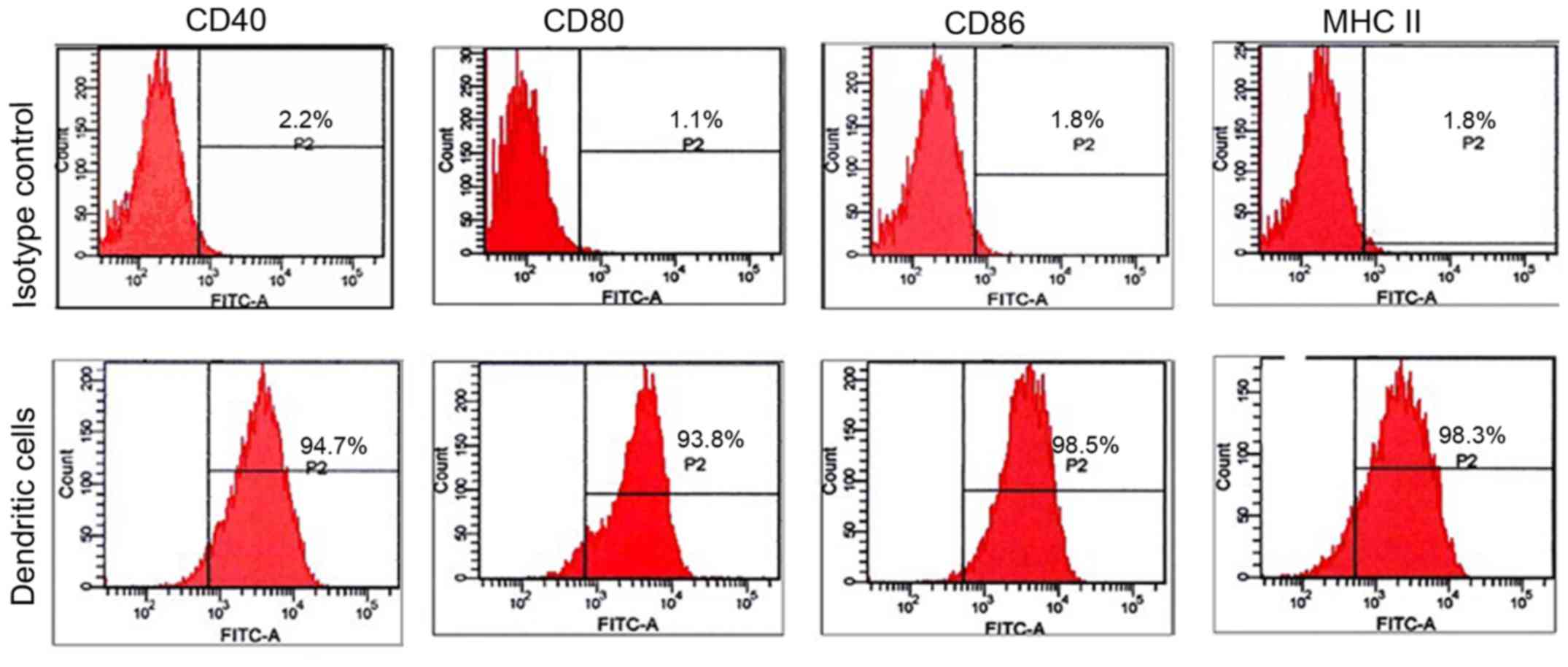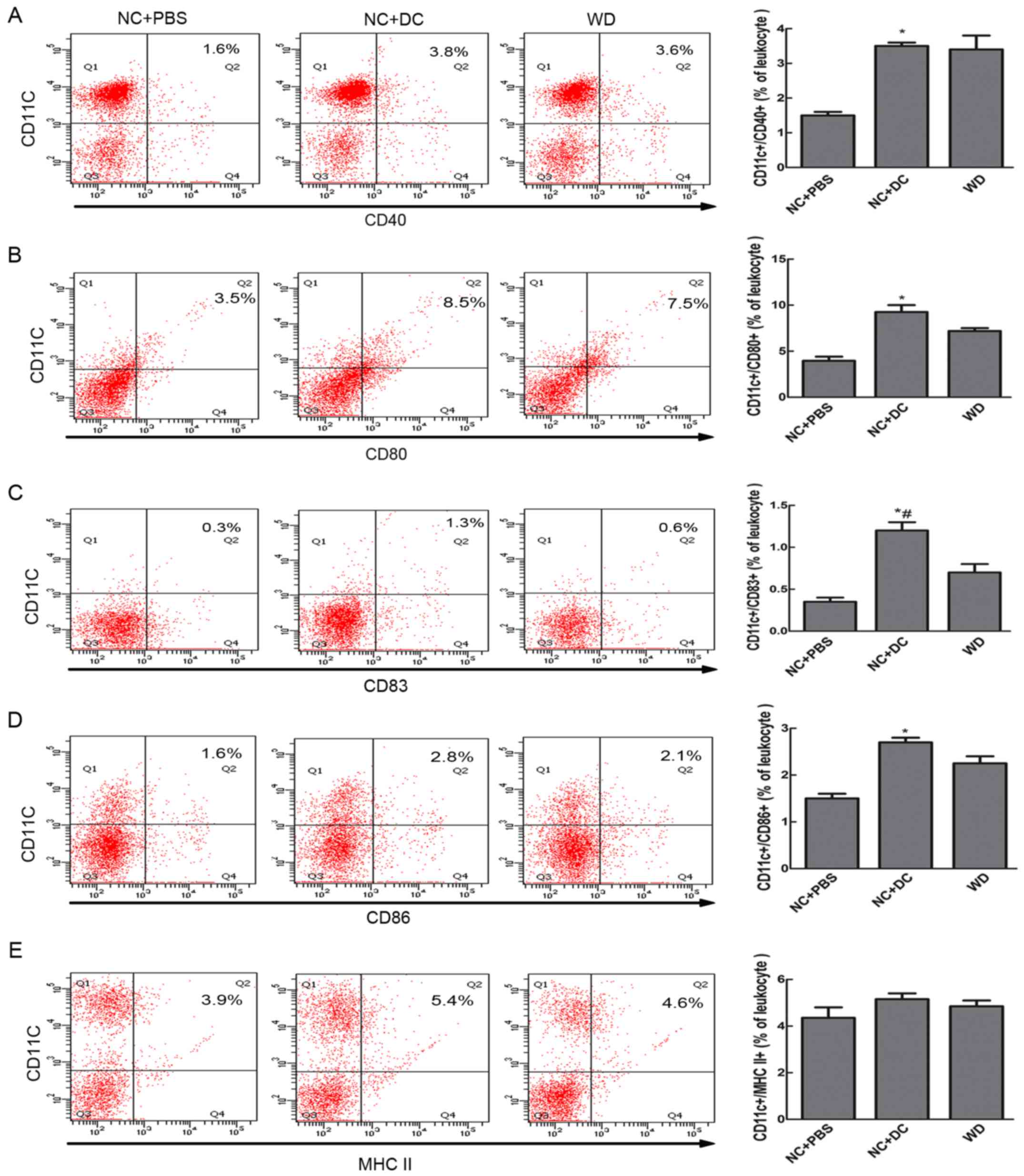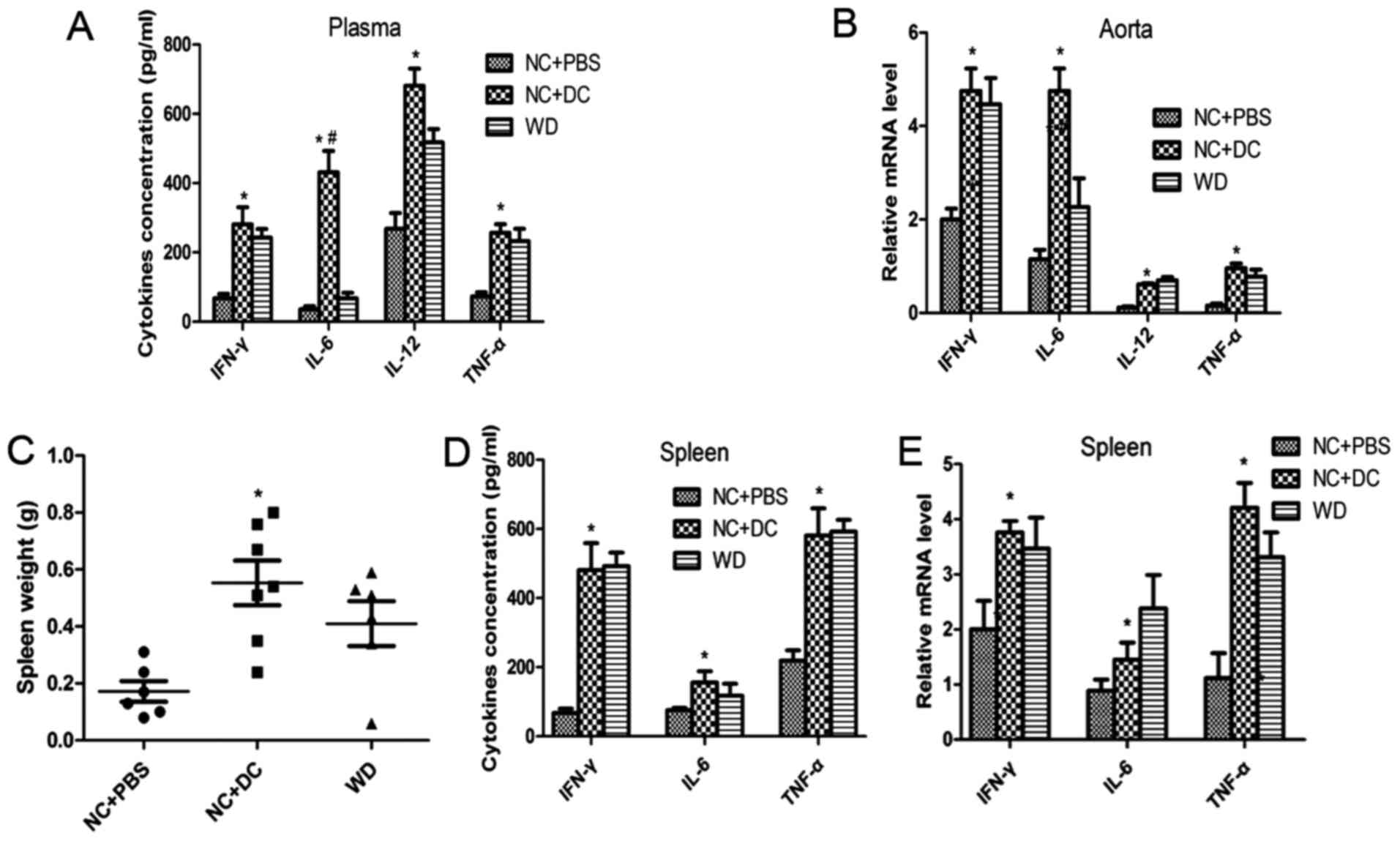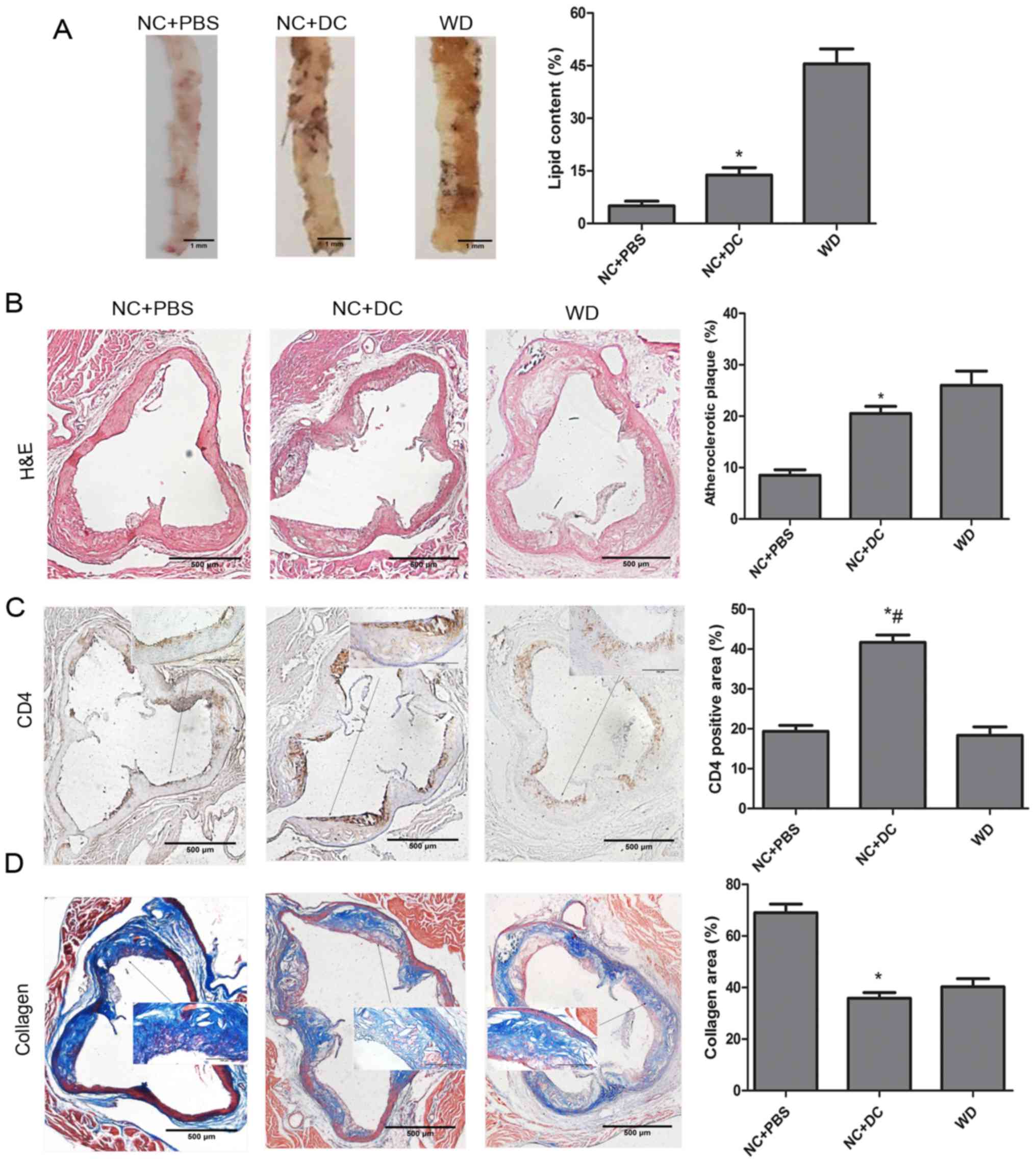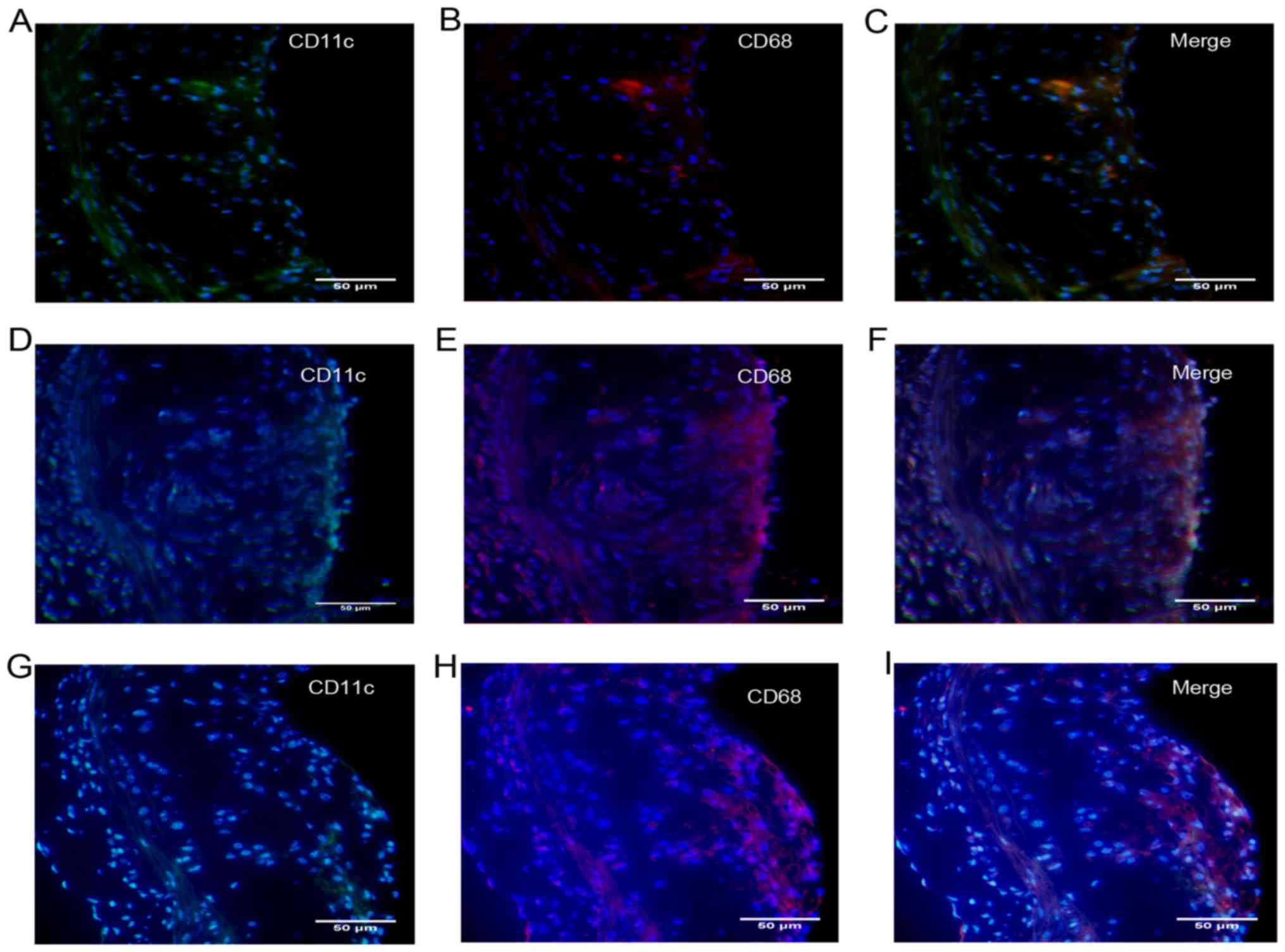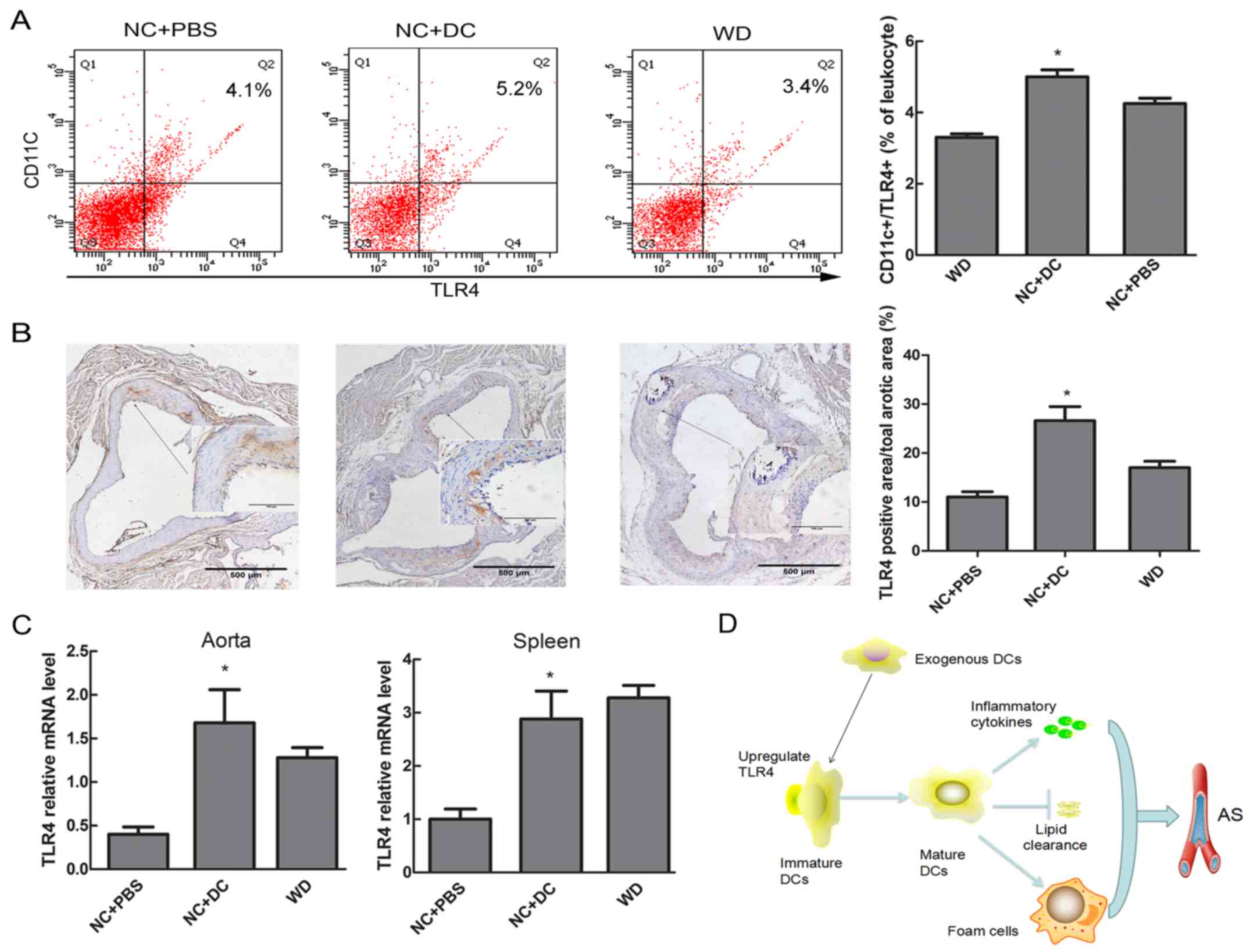Subcutaneous injection of dendritic cells aggravates atherosclerosis in ApoE‑knockout mice by activation of TLR4
- Authors:
- Published online on: August 23, 2017 https://doi.org/10.3892/mmr.2017.7339
- Pages: 6041-6049
-
Copyright: © Ye et al. This is an open access article distributed under the terms of Creative Commons Attribution License.
Abstract
Introduction
Atherosclerosis is a disorder in which the intima retains lipid, triggering a chronic inflammatory disease mediated by innate and adaptive immune responses (1,2). Dendritic cells (DCs) constitute a family of specialized antigen-presenting cells (APCs) that play a critical role as a link between the innate and adaptive immune responses (3). DCs have been identified in both the normal and pathological intima, thus they play a role in all stages of atherosclerosis, with multiple functions such as lipid accumulation, foam cell formation, pro-inflammatory cytokine secretion and antigen presentation (4–7). In most tissues, DCs are present in an immature state and the process of maturation is triggered in response to inflammatory stimulation. Upon maturation, DCs exhibit reduced antigen capture and uptake capacity, but increased antigen presentation ability and surface expression of major histocompatibility complex (MHC) class II and co-stimulatory molecules such as CD40, CD80, and CD86 (8,9). Therefore, the maturation of DCs is the key process in the activation of naïve T cells and mediation of the inflammatory cascade.
TLR signal pathways have been described as a crucial checkpoint for DC maturation by recognizing pathogen-associated molecular patterns (PAMPs) and inducing this signal pathway that ultimately causes cytokine production and upregulation of MHC II and co-stimulatory molecules by DCs (10). Previously, we demonstrated that in comparison with immature DCs, mature DCs expressed much higher levels of Toll-like receptor 4 (TLR4) mRNA in vitro and were better at stimulating T cell proliferation (in press). However, the question of whether DCs contribute to inflammation in vivo similar to their effect in vitro should be further investigated. In this study, we transferred bone marrow-derived DCs (BMDCs) from wild mice into ApoE−/− mice. These transferred exogenous DCs induced endogenous DC maturation in vivo by upregulation of TLR-4, which further increased the inflammatory response and accelerated atherosclerosis.
Materials and methods
Cells and animals
The principal method of generating BMDCs was adapted from that published by Son et al (11) with minor modifications and involved culturing bone marrow from C57BL/6 wild-type mice with 1,000 U/ml of granulocyte macrophage colony stimulating factor (GM-CSF) and interleukin (IL)-4 (R&D Systems, Minneapolis, MN, USA). CD11c+ DCs were selected using magnetic beads (Miltenyi Biotec, Auburn, CA, USA) according to the manufacturer's instructions. To stimulate DCs, 1 µg/ml of lipopolysaccharide (LPS; Sigma-Aldrich, St. Louis, MO, USA) was added from day 8 to day 9 to obtain mature DCs. The expression of surface molecules on DCs was analyzed by fluorescence-activated cell sorting (FACS, FACS Aria II; Becton Dickinson Immunocytometry Systems). ApoE−/− mice on a C57BL/6 background were purchased from Jackson Laboratory (Bar Harbor, ME, USA). Eight week-old ApoE−/− mice (male or female) were randomly assigned to one of three experimental groups (n=6–7). One group was injected subcutaneously inside the thigh with 1×106 purified DCs and then fed normal chow (NC), the second group received an equivalent volume of phosphate-buffered saline (PBS) and a diet of normal chow, while the third group was left untreated but fed a western diet (WD). Mice were kept under specific pathogen-free conditions, housed in a pathogen-free environment at Dalian Medical University and injected with DCs or PBS weekly for a total of 12 weeks. The investigation conformed to the National Institutes of Health guide for the Care and Use of Laboratory Animals (no. 8523, revised 1996; NIH Publications). They were then used in accordance with protocols approved by the Institutional Animal Care and Use Committee of Dalian Medical University (L2014030). All mice were sacrificed at about 20 weeks of age. After a 12 h overnight fast, animals were heavily sedated, and blood samples were drawn from the orbita immediately. For extraction of tissues, the spleen and the aorta from the aortic valve to the femoral bifurcation were removed and snap frozen at −80°C for later RNA extraction. In addition, some aorta tissues were stored in 10% buffered formalin at 4°C for histological staining.
Cytokines and plasma lipid analysis
Mouse plasma and spleen levels of interleukin (IL)-6, tumor necrosis factor (TNF)-α, IL-12p40 and IFN (interferon)-γ were determined by ELISA following the manufacturer's instructions (Abcam, Cambridge, UK). Briefly, plasma or tissue samples were obtained as indicated above and stored at −80°C prior to use. Microplate wells were respectively coated with purified rat anti-mouse IL-6, TNF-α, IL-12p40 or IFN-γ, followed by incubation with blocking buffer at room temperature for 1 h and subsequent washing with PBS. Subsequently, mouse plasma or tissue samples were added to the microplate wells and incubated for 2 h at room temperature, followed by incubation with biotin-labeled anti-mouse for IL-6, TNF-α, IL-12p40 or IFN-γ 1 h at room temperature. The absorbance at 450 nm was measured with a microplate reader (Thermo Fisher Scientifc, Inc., Waltham, MA, USA). Plasma total cholesterol and triglyceride levels as well as lipoprotein fractions were also determined following the manufacturer's instructions (Abcam).
Flow cytometric analysis
The expression of surface molecules on DCs in peripheral blood was analyzed by flow cytometry. At each step of the staining, 1×106 cells were stained with specific Abs for 1 h at 4°C in 100 µl of PBS containing 2% bovine serum albumin. We used fluorescein isothiocyanate (FITC) or phycoerythrin (PE)-labeled monoclonal Abs for staining of MHC class II (FITC), CD40 (FITC), CD80 (FITC), CD83 (FITC), CD86 (FITC), TLR-4 (FITC) and CD11c (PE). FITC- or PE-labeled IgG was substituted for isotype-matched controls. All Abs were purchased from BioLegend (San Diego, CA, USA).
Histological analysis
To assay the burden of lipid in the aorta, aorta samples were opened longitudinally and stained with Oil red O solution. Aortic roots were embedded in 10% buffered formalin for serial sections, 5 µm thick. Hematoxylin and eosin (H&E) staining was used to analyze lesions. Masson's trichrome was used to delineate the fibrous area. Immunohistochemistry was performed on paraffin sections of mouse aortic roots using rabbit anti-murine CD4 IgG (10 µg/ml) and rabbit anti-murine TLR4 IgG (10 µg/ml); DCs were identified by immunostaining with FITC-conjugated primary antibody against CD11c (5 µg/ml), and foam cells were identified by Alexa Fluor® 647-conjugated primary antibody against CD68 (5 µg/ml) (all from Abcam). Control immunostaining was performed using the respective non-immune IgG; no specific staining was observed. Quantification of positive area was performed using Image-Pro Plus 6.0 software (Media Cybernetics, Silver Spring, MD, USA).
Real-time RT-PCR analysis
Total RNA in aorta or spleen was extracted using the RNAiso Reagent Plus (Takara Bio Inc., Shiga, Japan), and complementary DNA (cDNA) was synthesized using an RT-PCR kit (Takara Bio Inc.) according to the manufacturer's recommendations. Table I shows the primer sequences and expected sizes of the products. Relative changes in mRNA expression were normalized with GAPDH and calculated using the 2−ΔΔCq method.
Statistical analysis
Statistical analyses were performed with GraphPad Prism version 5.0 (GraphPad Software, San Diego, CA, USA). Data are expressed as mean ± standard deviation. Statistical significance was determined by single factor analysis of variance (ANOVA) with Bonferroni correction. P<0.05 was considered to indicate a statistically significant result.
Results
Characterization of cultured DCs
BMDCs were cultured with GM-CSF and IL-4, and stimulated with LPS to obtain mature DCs. More than 90% of the purified cells expressed the surface markers of mature DCs: MHC II, CD40, CD80 and CD86 (Fig. 1).
Transfer of DCs increases DC maturation
To investigate the contribution of exogenous DCs to augmentation of the population of mature DCs in the peripheral blood of recipients, the percentage of CD11c+/CD40+, CD11c+/CD80+, CD11c+/CD86+, CD11c+/CD83+, and CD11c+/MHC II+ cells were analyzed by FACS. The results showed that mice treated with DCs showed higher expression of CD83 and co-stimulatory molecules compared to mice treated with PBS (cells positive for CD83+/CD11c+, CD11c+/CD40+, CD11c+/CD86+, and CD11c+/CD80+ made up 1.3, 3.8, 2.8, and 8.5%, respectively, vs. 0.3, 1.6, 1.6, and 3.5% in the mice treated with PBS, P<0.05, Fig. 2). Although the expression of MHC II in the mice receiving DCs did not differ significantly from that of the mice receiving PBS, the level was higher in the DC-treated mice. When compared with mice fed a WD, mice treated with DCs showed no significant difference in the expression of co-stimulatory molecules, MHC II or CD83. Thus, only ApoE−/− mice treated with exogenous DCs showed an increase in the maturation of DCs.
Transfer of DCs induces inflammatory activation in the recipients
As we report previously, maturation of DCs could activate naïve T cells and the inflammatory cascade. Next, we measured the concentrations of the cytokines IL-6, TNF-α, IFN-γ and IL-12p40 in the circulation and in atherosclerotic lesions. The plasma levels of IL-6, TNF-α, IFN-γ and IL-12p40 in the mice treated with DCs were all markedly higher compared to mice treated with PBS or those fed a WD (Fig. 3A), which is consistent with expression of those cytokines at the mRNA level in atherosclerotic lesions (Fig. 3B). Moreover, CD4+ T cell accumulation was markedly increased with DC treatment compared with the PBS treatment group (Fig. 4C). Strikingly, the mice treated with DCs exhibited increased spleen size compared to that of the mice treated with PBS (Fig. 3C). An intensified inflammatory reaction occurred in recipient mice after injection of exogenous DCs, and since inflammatory cells typically infiltrate and proliferate in the spleen, this may be thought to account for the splenomegaly. Next, we evaluated the content of cytokines at both protein and mRNA levels in spleen tissue. The protein and mRNA levels of IL-6, TNF-α, IFN-γ and IL-12p40 were all significantly upregulated in the mice treated with DCs compared with those treated with PBS (Fig. 3D and E). These data suggest that transfer of DCs induces inflammatory activation in the recipients.
Transfer of DCs aggravates aortic atherosclerosis
To evaluate the effect of transferring DCs on atherosclerosis, we first measured plasma lipid and lipoprotein levels. Compared with animals treated with PBS, mice treated with DCs exhibited significant increases in all lipid components except high-density lipoprotein (HDL) (Table II). Next, we analyzed total lipid burden by using en face preparation of the aorta and Oil red O staining. Computer-assisted quantitative histomorphometric analysis revealed a significant increase of the total aortic plaque burden in mice injected with exogenous DCs compared with those receiving PBS. Meanwhile, the mice fed a WD showed a serious lipid burden (Fig. 4A). Similarly, the atherosclerotic plaque area as a percentage of total aortic area was determined from H&E-stained histological sections of the aorta, which showed that, in mice treated with DCs, the area was remarkably increased compared to the mice treated with PBS (Fig. 4B). In addition, CD4+ T cell accumulation was markedly increased with DC treatment compared with the PBS treatment group (Fig. 4C). In contrast, collagen content, assessed by Masson's trichrome staining, was decreased by treatment with DCs compared with PBS (Fig. 4D). In summary, these results indicate serious aggravation of atherosclerosis after DC treatment in ApoE−/− mice.
Transfer of DCs increases DC recruitment and foam cell number in lesions
To further explore the characteristics of atherosclerosis following treatment with DCs, we quantified the number of DCs recruited into plaques. In addition, like macrophages, DCs have been shown to form foam cells in atherosclerotic lesions, most likely via the uptake of lipoproteins and lipid-laden apoptotic cells (12), so we also quantified the number of DC-derived foam cells in atherosclerotic plaques. Foam cells are derived primarily from monocytes/macrophages and a single monocyte/macrophage marker, such as CD68, has generally been used (13). In this study, DC-derived foam cells were co-stained with CD11c and CD68. After transfer of DCs, a large amount of CD11c/CD68-positive content was found in atherosclerotic lesions (Fig. 5), so we presumed that DCs in situ or those from the circulation had migrated into atherosclerotic lesions, become foam cells and been deposited in the lipid pool after disintegration.
Transfer of DCs upregulates expression of TLR4 in DCs
It is well established that activation of TLRs has been implicated in triggering the release of cytokines and the differentiation of immature to mature DCs, linking the innate immune system to the adaptive immune response (14). Thus, we explored whether expression of TLR4 in DCs coincided with similar changes of inflammatory cytokines and atherosclerotic lesions. Flow cytometric analysis showed that the expression of TLR-4 on DCs in peripheral blood tended to be higher in mice injected with DCs compared with mice treated with PBS (5.2% vs. 3.4%, P<0.05, Fig. 6A). Similarly, a significant increase in TLR4 expression at both protein and mRNA level was observed by immunohistochemistry and real-time RT-PCR in aortic tissue after transfer of DCs, as well as TLR4 mRNA level in spleen tissue (Fig. 6B and C).
Discussion
Accumulating evidence indicates a fundamental link between the immune system and atherosclerosis, but thus far this evidence has been mostly indirect (15). Depletion of plasmacytoid dendritic cells (pDCs) by injection of PDCA-1 antibody or mice with conditional depletion of DCs (DTR-CD11c transgenic mice) showed significantly reduced atherosclerotic plaque formation (16,17). Herein, we demonstrate that transferred exogenous BMDCs can increase atherosclerosis in ApoE−/− mice. DC maturation is associated with the secretion of pro-inflammatory cytokines and possesses the ability to robustly activate naïve T cells in an antigen-presenting manner, both of which are known to accelerate atherosclerosis (18,19). In our study we showed that expression of the costimulatory molecules, CD83 and MHC II, on circulating DCs was upregulated after intervention, indicating that the content of mature DCs was increased. Thereby, because of the noticeable ability of transferred DCs to activate inflammation, levels of the cytokines IL-6, TNF-α, IFN-γ and IL-12p40 were remarkably increased, which coincided with augmentation of the accumulation of CD4+ T cells in atherosclerotic lesions. In addition, we studied the role of transferred DCs on atherosclerotic plaques. As anticipated, our results with ApoE−/− mice after injection of exogenous DCs displayed a significant increase in atherosclerotic lesions with less collagen content, which can contribute to plaque instability.
The functional significance, if any, of lipid accumulation by DCs is not known and will be discussed below. For example, in WD-fed LDLR−/− and ApoE−/− background mice in which the lifespan of DCs was enhanced by CD11c-specific transgenic expression of the anti-apoptotic protein Bcl-2, there was a marked decrease in plasma cholesterol (20). However, we observed that elevation in the matured DC population after treatment with exogenous DCs led to markedly increased plasma cholesterol levels. This unexpected effect could be a consequence of a reduction of lipoprotein uptake and clearance of DCs from the circulation by maturation. Accumulation of foam cells in atherosclerotic plaques is a hallmark of atherogenesis (21). Moreover, dead foam cells have the effect of activating inflammation and promoting the growth of the necrotic area in a plaque, leading to plaque rupture and the occurrence of clinical events (22,23). As Paulson et al reported, lipid accumulation could be found within vascular DCs in the arterial intima of LDLR−/− mice after a few days of hypercholesterolemia, and the foam cell-like DCs may constitute the formation of atherosclerotic plaques (12). We observed similar results, with CD11c/CD68-positive content being abundant in the necrotic core of atherosclerotic plaques, which coincided with the severity of atherosclerosis. The deposition of foam cells in plaques has been implicated as a source of inflammatory cytokines, contributing to plaque rupture with hemorrhage and formation of thrombi.
As described, DCs are present in the immature state prior to antigen exposure, characterized by the ability to capture antigen but not expressing high levels of T cell costimulatory molecules or MHC II, while undergoing the progress of maturation, which is associated with downregulation of the capacity of antigen capture, upregulation of MHC II and CD40, CD80, CD86 and migration to draining lymph nodes or other immunization sites for antigen presentation to T cells (8). There is evidence that the TLR signaling pathway is a critical mediator of inflammation during atherosclerosis. More specifically, stimulation of DCs with TLR ligands induces DC maturation and activation in vivo and in vitro (24). In our previous study, monocyte-derived DCs were isolated and cultured from human peripheral blood, and shown to have increased levels of CD1a, CD80, CD83 and CD86 after stimulation appeared to coincide with the level of TLR4 (in press). Evidence for the involvement of TLR4 in the development of atherosclerosis is substantial, albeit largely indirect. However, one study reported that TLR4-deficient mice appeared to develop more severe atherosclerosis, perhaps due to the mechanism of impaired regulatory T cell infiltration, and especially, a reduction of DC IL-10, which is a regulatory T cell polarizing cytokine (25). Similarly, deficiency of MyD88 was associated with systemic defects in regulatory T cell development by blocking DC maturation, leading to severe atherosclerosis (26). These intriguing results may be due to the role of regulatory T cells, a subset of T cells that is well known to be atheroprotective by inhibiting pro-atherogenic Th1 cell response and activating macrophages or DCs by secreting anti-inflammatory cytokines such as IL-10 and TGF-β (27,28). However, our study suggested that the upregulation of TLR4 was correlated in general with the maturation of DCs, as well as the extent of atherosclerosis; thus, we speculate that activation of the TLR4 pathway has a dominant effect on the pro-atherogenic role of DCs in activating T cells over the atheroprotective role of regulatory T cells in our model.
In this study, we report that injection of exogenous DCs could upregulative the expression of TLR4 on DCs, leading to activation of inflammatory mediators in the circulation and enhancing the number of DCs infiltrating into lesions, both of which aggravate atherosclerosis development. Our work represents an important step in establishing the important role of DCs in atherosclerosis and identifying a link between TLR4 signaling and atherosclerosis in vivo. However, further investigation will be required to elucidate the functions of DCs during the progression of atherosclerosis. Given the pro- and anti-inflammatory functions of DCs, it is conceivable that their role in atherosclerosis is complex.
Acknowledgements
The authors thank Dr Dai Liu and Dr Shengnan Zhu in the Department of Cardiology of the First Affiliated Hospital of Dalian Medical University for animal care, cell isolation and culture. This study was supported by the National Natural Science Foundation of China (81100220 and 8167020454).
References
|
Libby P: Inflammation in atherosclerosis. J Associat Physicians India. 48:265–266. 2012. | |
|
Ross R: Atherosclerosis-an inflammatory disease. N Engl J Med. 340:115–126. 1999. View Article : Google Scholar : PubMed/NCBI | |
|
Banchereau J and Steinman RM: Dendritic cells and the control of immunity. Nature. 392:245–252. 1998. View Article : Google Scholar : PubMed/NCBI | |
|
Bobryshev YV and Watanabe T: Subset of vascular dendritic cells transforming into foam cells in human atherosclerotic lesions. Cardiovasc Pathol. 6:321–331. 1997. View Article : Google Scholar : PubMed/NCBI | |
|
Chistiakov DA, Sobenin IA, Orekhov AN and Bobryshev YV: Dendritic cells in atherosclerotic inflammation: The complexity of functions and the peculiarities of pathophysiological effects. Front Physiol. 5:1962014. View Article : Google Scholar : PubMed/NCBI | |
|
Choi J, Do Y, Cheong C, Koh H, Boscardin SB, Oh YS, Bozzacco L, Trumpfheller C, Park CG and Steinman RM: Identification of antigen-presenting dendritic cells in mouse aorta and cardiac valves. J Exp Med. 206:497–505. 2009. View Article : Google Scholar : PubMed/NCBI | |
|
Koltsova EK and Ley K: How dendritic cells shape atherosclerosis. Trends Immunol. 32:540–547. 2011. View Article : Google Scholar : PubMed/NCBI | |
|
Mellman I and Steinman RM: Dendritic cells: Specialized and regulated antigen processing machines. Cell. 106:255–258. 2001. View Article : Google Scholar : PubMed/NCBI | |
|
Chen L: Co-inhibitory molecules of the B7-CD28 family in the control of T-cell immunity. Nat Rev Immunol. 4:336–347. 2004. View Article : Google Scholar : PubMed/NCBI | |
|
Akira S and Takeda K: Toll-like receptor signalling. Nat Rev Immunol. 4:499–511. 2004. View Article : Google Scholar : PubMed/NCBI | |
|
Son YI, Egawa S, Tatsumi T, Redlinger RE Jr, Kalinski P and Kanto T: A novel bulk-culture method for generating mature dendritic cells from mouse bone marrow cells. J Immunol Methods. 262:145–157. 2002. View Article : Google Scholar : PubMed/NCBI | |
|
Paulson KE, Zhu SN, Chen M, Nurmohamed S, Jongstra-Bilen J and Cybulsky MI: Resident intimal dendritic cells accumulate lipid and contribute to the initiation of atherosclerosis. Circ Res. 106:383–390. 2010. View Article : Google Scholar : PubMed/NCBI | |
|
Rong JX, Shapiro M, Trogan E and Fisher EA: Transdifferentiation of mouse aortic smooth muscle cells to a macrophage-like state after cholesterol loading. Proc Natl Acad Sci USA. 100:13531–13536. 2003; View Article : Google Scholar : PubMed/NCBI | |
|
Ling GS, Bennett J, Woollard KJ, Szajna M, Fossati-Jimack L, Taylor PR, Scott D, Franzoso G, Cook HT and Botto M: Integrin CD11b positively regulates TLR4-induced signalling pathways in dendritic cells but not in macrophages. Nat Commun. 5:30392014. View Article : Google Scholar : PubMed/NCBI | |
|
Chávez-Sánchez L, Espinosa-Luna JE, Chávez-Rueda K, Legorreta-Haquet MV, Montoya-Díaz E and Blanco-Favela F: Innate immune system cells in atherosclerosis. Arch Med Res. 45:1–14. 2014. View Article : Google Scholar : PubMed/NCBI | |
|
Macritchie N, Grassia G, Sabir SR, Maddaluno M, Welsh P, Sattar N, Ialenti A, Kurowska-Stolarska M, McInnes IB, Brewer JM, et al: Plasmacytoid dendritic cells play a key role in promoting atherosclerosis in apolipoprotein E-deficient mice. Arterioscler Thromb Vasc Biol. 32:2569–2579. 2012. View Article : Google Scholar : PubMed/NCBI | |
|
Weeks MF, Rampersad RR and Liu P: Dendritic cells and macrophages contribute differently to the initiation of atherosclerosis. Circulation. 126:A157152012. | |
|
Hansson GK and Hermansson A: The immune system in atherosclerosis. Nat Immunol. 12:204–212. 2011. View Article : Google Scholar : PubMed/NCBI | |
|
Mempel TR, Henrickson SE and Von Andrian UH: T-cell priming by dendritic cells in lymph nodes occurs in three distinct phases. Nature. 427:154–159. 2004. View Article : Google Scholar : PubMed/NCBI | |
|
Gautier EL, Huby T, Saint-Charles F, Ouzilleau B, Pirault J, Deswaerte V, Ginhoux F, Miller ER, Witztum JL, Chapman MJ and Lesnik P: Conventional dendritic cells at the crossroads between immunity and cholesterol homeostasis in atherosclerosis. Circulation. 119:2367–2375. 2009. View Article : Google Scholar : PubMed/NCBI | |
|
Glass CK and Witztum JL: Atherosclerosis: The road ahead. Cell. 104:503–516. 2001. View Article : Google Scholar : PubMed/NCBI | |
|
Hamada M, Nakamura M, Tran MT, Moriguchi T, Hong C, Ohsumi T, Dinh TT, Kusakabe M, Hattori M, Katsumata T, et al: MafB promotes atherosclerosis by inhibiting foam-cell apoptosis. Nat Commun. 5:31472014. View Article : Google Scholar : PubMed/NCBI | |
|
Liu SW, Qiao SB, Yuan JS and Liu DQ: Association of plasma visfatin levels with inflammation, atherosclerosis and acute coronary syndromes (ACS) in humans. Clin Endocrinol (Oxf). 71:202–207. 2009. View Article : Google Scholar : PubMed/NCBI | |
|
de Kleijn D and Pasterkamp G: Toll-like receptors in cardiovascular diseases. Cardiovasc Res. 60:58–67. 2003. View Article : Google Scholar : PubMed/NCBI | |
|
Hayashi C, Papadopoulos G, Gudino CV, Weinberg EO, Barth KR, Madrigal AG, Chen Y, Ning H, LaValley M, Gibson FC III, et al: Protective role for TLR4 signaling in atherosclerosis progression as revealed by infection with a common oral pathogen. J Immunol. 189:3681–3688. 2012. View Article : Google Scholar : PubMed/NCBI | |
|
Subramanian M, Thorp E, Hansson GK and Tabas I: Treg-mediated suppression of atherosclerosis requires MYD88 signaling in DCs. J Clin Invest. 123:179–188. 2013. View Article : Google Scholar : PubMed/NCBI | |
|
Alroqi FJ and Chatila TA: T regulatory cell biology in health and disease. Curr Allergy Asthma Rep. 16:272016. View Article : Google Scholar : PubMed/NCBI | |
|
Sakaguchi S, Yamaguchi T, Nomura T and Ono M: Regulatory T cells and immune tolerance. Cell. 133:775–787. 2008. View Article : Google Scholar : PubMed/NCBI |



